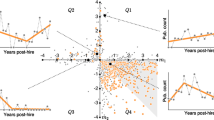Abstract—
The multicriteria problem of optimizing the state regulation of the quality of human capital in an information society is considered. A discrete dynamic model of human capital is described taking into account the age dynamics of the awareness and cognitive abilities possessed by an individual as a carrier of information. On trajectories, The lifelong indices of human capital are considered on trajectories; i.e., productivity and creativity are considered taking into account the initial increase in the quality of human capital followed by its subsequent decline at an older age. The task of state regulation is described as a two-criteria maximization of the population’s mathematical expectations of indices for a generation, taking into account not only the natural distribution of individuals by the starting values but also the possibilities of socialization within a state-controlled education system. The model’s identification is based on taking into account the known population restrictions on the phase trajectory tube. The model is identified and investigated by methods using approximation by Shannon metric networks. It is shown that the optimal choice of educational priorities by the state depends on the society’s parameters such as age-specific mortality rates and the time budget available for the socialization of a nonadult. There are combinations of parameters that lead to a conflict of the regulation criteria; in this case the solution is the set of Pareto optimal strategies. For Russia, there is a dominant solution that presumes the priority development of cognitive abilities rather than awareness.





Similar content being viewed by others
REFERENCES
G. S. Becker, Human Capital: Theoretical and Empirical Analysis, with Special Reference to Education (National Bureau of Economic Research, New York, 1964).
J. E. Hunter, “Cognitive ability, cognitive aptitudes, job knowledge, and job performance,” J. Vocat. Behav. 29 (3), 340–362 (1986).
G. K. Kamenev and I. G. Kamenev, “Application of multivariate analysis methods to study sociological populations,” in Trudy Otd. Mat. Model. Ekon. Sist. VC FIC IU RAN (Vychisl. Tsentr im. Dorodnitsyna Ross. Akad. Nauk, Moscow, 2017), pp.58–93 [in Russian].
G. K. Kamenev, “Calibration of dynamic models with conditions on the trajectory tube,” in Proc. IX Moscow Int. Conf. on Operations Research (ORM2018), Moscow, October 22–27, 2018 (MAKS Press, Moscow, 2018), Vol. 2, pp. 360–364 [in Russian].
G. K. Kamenev and I. G. Kamenev, “The model of human as information carrier and its metric data analysis,” in New Trends, Strategies and Structural Changes in Emerging Markets: Conf. Proc. VII Int. Conf., Moscow, May 29–31, 2018 (Ross. Univ. Druzhby Nar., Moscow, 2018), pp. 67–69. Full text at https://doi.org/10.13140/RG.2.2.32707.45602
A. V. Lotov, V. A. Bushenkov, and G. K. Kamenev, Interactive Decision Maps: Approximation and Visualization of Pareto Frontier, Applied Optimization, Vol. 89 (Springer, Boston, MA, 2004).
C. E. Shannon, “A mathematical theory of communication,” Bell Syst. Tech. J. 27 (3), 379–423, 623–656 (1948).
G. K. Kamenev, “Approximation of completely bounded sets by the deep holes method,” Comput. Math. Math. Phys. 41 (11), 1667–1675 (2001).
G. K. Kamenev, “A multicriteria method for identification and forecasting,” Math. Models Comput. Simul. 10 (2), 154–163 (2018).
T. A. Salthouse, “Within-cohort age-related differences in cognitive functioning,” Psychol. Sci. 24 (2), 123–130 (2013).
Healthcare in Russia. Stat. Digest (Rosstat, Moscow, 2017) [in Russian].
Funding
This study was supported in part by the Russian Foundation for Basic Research, project no. 18-01-00465 a.
Author information
Authors and Affiliations
Corresponding author
Additional information
Translated by I. Pertsovskaya
Rights and permissions
About this article
Cite this article
Kamenev, G.K., Kamenev, I.G. Discrete Dynamic Modeling of State Regulation of Human Capital. Math Models Comput Simul 13, 144–153 (2021). https://doi.org/10.1134/S2070048221010105
Received:
Revised:
Accepted:
Published:
Issue Date:
DOI: https://doi.org/10.1134/S2070048221010105




